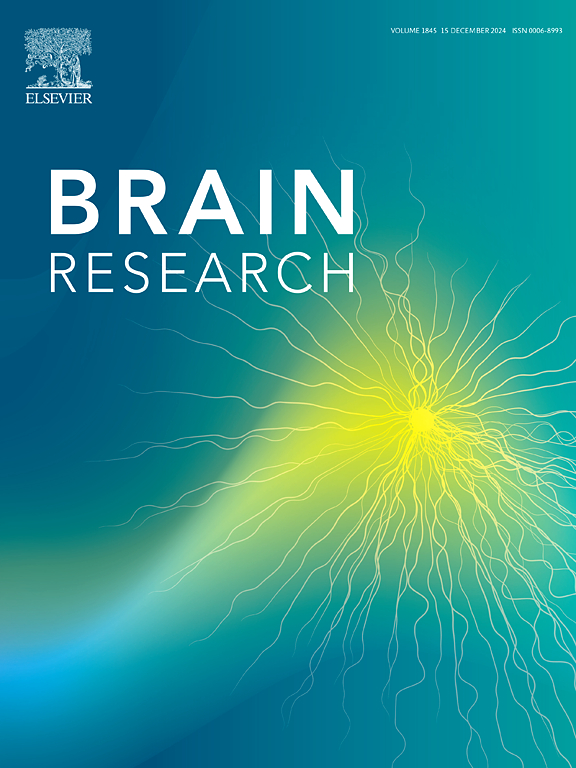脑卒中患者压力中心与大脑皮层激活特征的相关性:功能性近红外光谱研究
IF 2.7
4区 医学
Q3 NEUROSCIENCES
引用次数: 0
摘要
平衡障碍在卒中后偏瘫患者中很常见,但睁眼和闭眼状态下站立平衡与大脑皮层激活之间的关系尚不清楚。本研究旨在探索这些相关性,以指导有针对性的神经调节。对复旦大学华山医院卒中患者31例(2021-2022)在上述条件下的压力中心摇摆(COP)进行评估。用功能近红外光谱(fNIRS)测量脑激活系数β值。Pearson相关分析显示,睁眼站立时,右侧运动前皮质(PMC)和辅助运动区(SMA)与COP运动区的短时离散度(r = 0.56, P = 0.001)、COP速度的长时离散度(r = 0.57, P <;0.001), COP内侧-外侧-加速度(r = 0.63, P <;0.001), COP的中侧向速度(r = 0.63, P <;0.001),得分(r = 0.56, P = 0.001)。双侧PMC、SMA、左前额叶眼动和左初级运动皮层也与COP的中侧向速度有显著相关性(r = 0.48-0.56,均P <;0.01)。配对样本t检验显示,睁眼和闭眼条件下几乎所有COP变量都存在显著差异(P <;0.05),但各通道平均大脑皮层激活量无显著差异。我们的研究结果表明,在受影响半球的运动区域具有最强代表性的通道可能是平衡障碍的重要调节靶点。本文章由计算机程序翻译,如有差异,请以英文原文为准。
The correlation between center of pressure and cerebral cortex activation characteristics in patients with stroke: A functional near-infrared spectroscopy study
Balance impairment is common among patients with hemiplegia after stroke, yet the relationship between standing balance and cerebral cortex activation under eyes-open and eyes-closed conditions remains unclear. This study aims to explore these correlations to guide targeted neural regulation. Thirty-one stroke patients from Huashan Hospital, Fudan University (2021–2022), were assessed for the sway of center of pressure (COP) under the aforementioned conditions. Brain activation coefficient β value was measured using functional near-infrared spectroscopy (fNIRS). Pearson’s correlation analysis showed that during standing with eyes open, the right pre-motor cortex (PMC) and supplementary motor area (SMA) was moderately correlated with short-time dispersion degree of the COP movement area (r = 0.56, P = 0.001), long-time dispersion of the COP velocity (r = 0.57, P < 0.001), medial–lateral-acceleration of the COP (r = 0.63, P < 0.001), medial–lateral-speed of the COP (r = 0.63, P < 0.001), and the Score (r = 0.56, P = 0.001). Significant correlations with medial–lateral-speed of the COP were also found in the bilateral PMC, SMA, the left prefrontal eye movement and the left primary motor cortex (r = 0.48–0.56, all P < 0.01). Paired-samples t-tests showed significant differences in almost all COP variables between eyes-open and eyes-closed conditions (P < 0.05), but no significant differences in in the mean cerebral cortex activation across all channels. Our findings indicate that the channel with the strongest representation of the motor area of the affected hemisphere may be an important regulatory target for balance disorders.
求助全文
通过发布文献求助,成功后即可免费获取论文全文。
去求助
来源期刊

Brain Research
医学-神经科学
CiteScore
5.90
自引率
3.40%
发文量
268
审稿时长
47 days
期刊介绍:
An international multidisciplinary journal devoted to fundamental research in the brain sciences.
Brain Research publishes papers reporting interdisciplinary investigations of nervous system structure and function that are of general interest to the international community of neuroscientists. As is evident from the journals name, its scope is broad, ranging from cellular and molecular studies through systems neuroscience, cognition and disease. Invited reviews are also published; suggestions for and inquiries about potential reviews are welcomed.
With the appearance of the final issue of the 2011 subscription, Vol. 67/1-2 (24 June 2011), Brain Research Reviews has ceased publication as a distinct journal separate from Brain Research. Review articles accepted for Brain Research are now published in that journal.
 求助内容:
求助内容: 应助结果提醒方式:
应助结果提醒方式:


